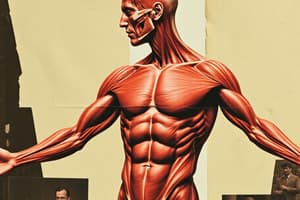Podcast
Questions and Answers
Which type of muscle contraction involves the shortening of muscle fibers?
Which type of muscle contraction involves the shortening of muscle fibers?
- Eccentric
- Concentric (correct)
- Isotonic
- Isometric
What is the primary function of muscles in the body?
What is the primary function of muscles in the body?
- Assisting with circulation
- Movement, posture, joint stability, and heat production (correct)
- Supporting the skeletal system
- Regulating body temperature
What percentage of the heat produced in the body is attributed to muscle metabolism?
What percentage of the heat produced in the body is attributed to muscle metabolism?
- 70%
- 50%
- 85% (correct)
- 90%
What type of muscle contraction occurs when a muscle contracts without changing its length?
What type of muscle contraction occurs when a muscle contracts without changing its length?
What is released at the neuromuscular junction to initiate muscle contraction?
What is released at the neuromuscular junction to initiate muscle contraction?
What happens to muscle fibers during an eccentric contraction?
What happens to muscle fibers during an eccentric contraction?
What gives skeletal muscles a striated appearance?
What gives skeletal muscles a striated appearance?
Which muscle type is responsible for moving the body through voluntary actions?
Which muscle type is responsible for moving the body through voluntary actions?
Which muscle type is responsible for pumping blood through the cardiovascular system?
Which muscle type is responsible for pumping blood through the cardiovascular system?
What is the type of control under which smooth muscles operate?
What is the type of control under which smooth muscles operate?
Which type of muscles do not contain sarcomeres?
Which type of muscles do not contain sarcomeres?
What is the main process by which muscles generate force and movement?
What is the main process by which muscles generate force and movement?
Flashcards are hidden until you start studying
Study Notes
Muscular System
The muscular system is a complex network of specialized cells called muscle fibers. These cells are responsible for the generation of force and movement in the body. Muscles are attached to bones, internal organs, and blood vessels, playing a crucial role in movement, support, and the maintenance of body functions. There are three types of muscle tissue in the body: skeletal, cardiac, and smooth.
Types of Muscles
Skeletal Muscles
Skeletal muscles are part of the musculoskeletal system and are attached to bones. They are responsible for moving the body through voluntary actions. Skeletal muscles are composed of myofibrils, which contain actin and myosin filaments organized into repeating arrays called sarcomeres. These sarcomeres give skeletal muscles a striated appearance.
Cardiac Muscles
Cardiac muscles make up the middle layers of the heart and are responsible for pumping blood through the cardiovascular system. Cardiac muscles are striated and are under involuntary control by the autonomic nervous system (ANS).
Smooth Muscles
Smooth muscles are found throughout the body, including the blood vessels, gastrointestinal tract, bronchioles, uterus, and bladder. Unlike skeletal and cardiac muscles, smooth muscles do not contain sarcomeres and are under involuntary control by reflexes and the ANS.
Muscle Contractions
Muscle contractions are the process by which muscles generate force and movement. There are four types of striated muscle contractions: isometric, isotonic, concentric, and eccentric.
Isometric Contraction
Isometric contractions occur without changes in muscle length. They are seen when pushing against an immovable object or trying to lift a weight that is too heavy.
Isotonic Contraction
Isotonic contractions involve changes in muscle length and tension. They are seen during activities such as walking, running, and lifting weights.
Concentric Contraction
Concentric contractions involve the shortening of muscle fibers. They are seen when a muscle contracts and moves an object, such as lifting a weight.
Eccentric Contraction
Eccentric contractions involve the lengthening of muscle fibers. They are seen when a muscle contracts while an external force is applied, such as lowering a weight.
Muscle Function
Muscles serve a variety of functions in the body. They are responsible for movement, posture, joint stability, and heat production. Heat production, which accounts for nearly 85 percent of the heat produced in the body, is an important by-product of muscle metabolism.
Muscle Mechanism
The mechanism of muscle contraction involves a complex process of chemical reactions within muscle fibers. When a message from the nervous system reaches the neuromuscular junction, a chemical message called acetylcholine is released, which then interacts with receptors on the muscle fiber, initiating a series of events that lead to muscle contraction. The contraction occurs as a result of the reorganization of the muscle fibers' proteins, which shortens the muscle. When the nervous system signal is no longer present, the chemical reaction that causes the rearrangement of the muscle fibers' proteins is stopped, and the muscle relaxes.
Studying That Suits You
Use AI to generate personalized quizzes and flashcards to suit your learning preferences.




